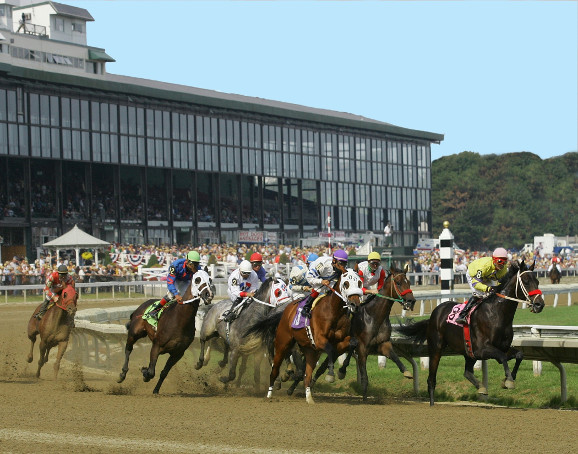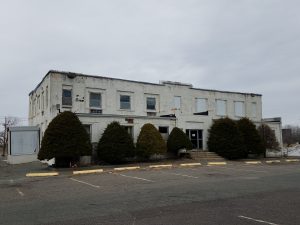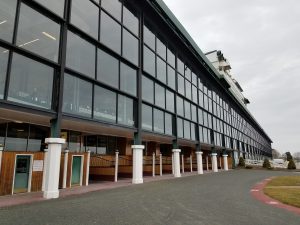
March 28, 2017 Historic Suffolk Downs Faces the Future
It was announced several weeks ago that the owners of the 161-acre Suffolk Downs had been purchased by Boston developer HYM Investment Group for new development. After several years of speculation and 87 years of horseracing and entertainment — this Boston landmark is on a path to a new future.

Seabiscuit Monument
We thought we’d take a look at the history of Suffolk Downs and what buildings and landscapes remain from its storied past that might inform future of development at this East Boston gateway into the city.
Tens of thousands of greater Bostonians have spent time at Suffolk Downs, watching and betting on horse-races, or attending large scale concerts and events. In 1936, the great thoroughbred Seabiscuit was discovered here and, with jockey Red Pollard, won the prestigious MassCap in 1937. Beyond racing, Suffolk Downs has been the backdrop to memorable musical and theatrical events, most memorably The Beatles in 1966.

Clubhouse
In the late 19th century, thoroughbred horse-racing was increasingly popular as American cities grew and their residents claimed more time for recreation. In Boston, Hyde Park and Roxbury had racetracks, and today’s Charles River Speedway buildings on Soldiers Field Road commemorate the harness racing track that once ran along banks of the river in Allston. The Commonwealth created a racing commission and legalized a pari mutuel betting system in 1934 to dodge the illegal bookmaking that had plagued the sport throughout the country. This cleared the way for the construction of Suffolk Downs the oldest of several similar parks built around the Commonwealth and the only one to remain associated with thoroughbred racing until recently built by owner Charles F. Adams, also the founder of the Boston Bruins.
Begun in 1935, the Suffolk Downs we know today is the accumulation of four periods of building, and each of those construction projects reflects a different era of design and architecture, and the ever-changing American tastes in popular pastimes.
It was built on marshland that had been filled in around 1890 that were filled by the Boston Land Company in order to foster new development. Mark Linenthal, a Boston engineer, designed the new racepark. In his career, Linenthal designed many racing facilities and ballparks in Rhode Island and New York.
Remaining buildings from the 1930s include the Art Deco Clubhouse, the grandstand, and the Administration building? The Administration building has suffered a roof collapse and substantial deterioration. It sits empty and forlorn in the parking lot in front of the Suffolk Downs Clubhouse.
Further afield and away from the public eye are acres of horsebarns 30-odd low rise wooden structures that were constructed in the 1930s and today are surrounded by fences. There is also a semicircular pony barn at the end of the racing track from this period that is in poor condition.

Administrative Building
Throughout the 1940s and 50s modifications were made to the open air grandstand, beginning their gradual enclosure. Linenthal’s firm was engaged again from 1962 to 1965 for the site’s most expansive changes including construction of a modernist concrete grandstand extension and a contemporaneous expansion of the clubhouse with a vaulted concrete entry. That clubhouse addition was replaced in 1991 with a mirror image of the Deco clubhouse facade of the 1930s.
And while the landscape of buildings and walkways has changed over time, the 1-mile oval racetrack and the mile harness-racing track within it remains the same.
It was announced in 2014 that the facility had been sold, and that horseracing would continue until 2018. Very little racing takes place at Suffolk Downs today, but you can spend an afternoon watching televised races at the property’s clubhouse.

Grandstand
In a future that most speculate will lead to considerable new development on this property, what will remain of this 8 place that features prominently in the memories of Bostonians? There are no preservation constraints here (although the Massachusetts Historical Commission produced an excellent inventory and narrative for the site). However, one can imagine pieces of its 20th century history as anchor to a 21st century development.
Could the sadly deteriorated Administration building could be restored? The 1930s Art Deco Clubhouse be preserved? Could the original grandstand be revealed and used for a new recreational space, like the Institute of Contemporary Art’s grandstand? Could some of the stables be re-positioned for unique commercial uses? And might the racetracks be re-thought as recreational space for a newly built community?
In 2014 in the Boston Globe, Historic Boston’s Executive Director, Kathy Kottaridis, suggested that new development at Suffolk Downs should be inspired by the many years Bostonian’s used it for recreation and enjoyment. There’s a lot to consider in a new development on filled land that abuts the harbor and history should be one of them. Time will tell.



